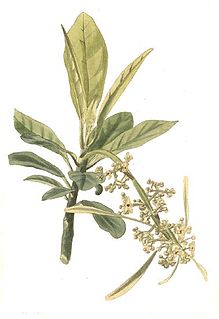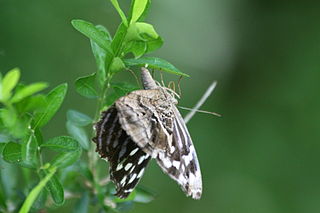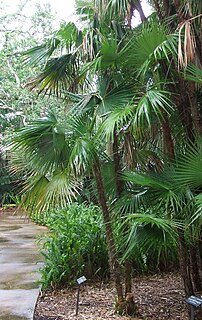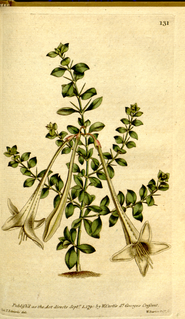
Omphalea is a plant genus of the family Euphorbiaceae first described as a genus in 1759. It is native to tropical parts of the Americas, the West Indies, Asia, Australia, and Africa.

Adelia is a genus of flowering plants in the spurge family, Euphorbiaceae, subfamily Acalyphoideae. It is native to Latin America and the Caribbean, with one species extending northward into the southernmost part of Texas.
Lasiocroton is a plant genus of the family Euphorbiaceae first described as a genus in 1859. The genus is endemic to the West Indies. It is a member of the Leucocroton alliance, which also includes Leucocroton and Garciadelia. Species in this alliance are dioecious.
- Lasiocroton bahamensisPax & K.Hoffm. - Bahamas, Cuba, Haiti
- Lasiocroton fawcettiiUrb. - Jamaica
- Lasiocroton gracilisBritton & P.Wilson - SE Cuba
- Lasiocroton gutierreziiJestrow - Cuba
- Lasiocroton harrisiiBritton - Jamaica
- Lasiocroton macrophyllus(Sw.) Griseb. - Jamaica
- Lasiocroton microphyllus(A.Rich.) Jestrow - Cuba
- moved to other genera (Bernardia Croton Leucocroton)
- Lasiocroton cordifoliusBritton & P.Wilson - Leucocroton cordifolius (Britton & P.Wilson) Alain
- Lasiocroton prunifoliusGriseb. - Croton punctatusJacq.
- Lasiocroton subpeltatusUrb. - Leucocroton subpeltatus(Urb.) Alain
- Lasiocroton trelawniensisC.D.Adams - Bernardia trelawniensis(C.D.Adams) Jestrow & Proctor

Leucocroton is a plant genus of the family Euphorbiaceae first described as a genus in 1861. The entire genus is endemic to Cuba. It is a member of the Leucocroton alliance, which also includes Garciadelia and Lasiocroton. Species in this alliance are dioecious.
Bernardia is a plant genus of the family Euphorbiaceae first described for modern science as a genus in 1754. It is native to North and South America, as well as the West Indies.
Bonania is a plant genus of the family Euphorbiaceae first described as a genus in 1850. It is native to the West Indies.
- Bonania cubanaA.Rich. - Bahamas, Cuba
- Bonania domingensis(Urb.) Urb. - Haiti, Dominican Rep
- Bonania ellipticaUrb. - Cuba
- Bonania emarginataC.Wright ex Griseb. - Cuba
- Bonania erythrosperma(Griseb.) Benth. & Hook.f. ex B.D.Jacks. - Cuba
- Bonania linearifoliaUrb. & Ekman - Haiti
- †Bonania myricifolia(Griseb.) Benth. & Hook.f. - Guantánamo but extinct

Zombia antillarum, commonly known as the zombie palm, is a species of palm tree and the only member of the genus Zombia. It is endemic to the island of Hispaniola in the Greater Antilles. Usually found in dry, hilly areas of northern and southern Haiti and the northwest of the Dominican Republic, Z. antillarum is a relatively short fan palm with clustered stems and a very distinctive appearance caused by its persistent spiny leaf sheaths. Threatened by habitat destruction in Haiti, Z. antillarum is a popular ornamental species due to its distinctive appearance, low maintenance requirements and salt tolerance.
The Caribbean bioregion is a biogeographic region that includes the islands of the Caribbean Sea and nearby Atlantic islands, which share a fauna, flora and mycobiota distinct from surrounding bioregions.
Coccothrinax jamaicensis, the silver thatch or Jamaican silver thatch, is a fan palm believed to be endemic to Jamaica. A slender palm growing up to 8 metres (26 ft) tall, it grows in coastal areas on limestone or sand.

Hippomane spinosa is a plant species in the family Euphorbiaceae.

Dendrophylax is a genus of leafless neotropical orchids native to Mexico, Central America, the West Indies, and Florida. The name is from Greek δένδρον ("tree") and φύλαξ. One species, Dendrophylax lindenii, featured heavily in the book The Orchid Thief.
Croton barahonensis is a species of plant of the genus Croton and the family of Euphorbiaceae, present in the Dominican Republic on the island of Hispaniola.

Catesbaea is a genus of flowering plants in the family Rubiaceae. It occurs in the West Indies, The Bahamas, and the Florida Keys. The genus is named in honour of English naturalist Mark Catesby.
Colleteria is a genus of flowering plants in the family Rubiaceae. The genus is found in the Caribbean.
Calyptrogenia is a genus of flowering plants in the family Myrtaceae first described as a genus in 1941. It is native to two islands in the West Indies: Jamaica and Hispaniola.
- Calyptrogenia bifloraAlain - Sierra Prieta in Dominican Republic
- Calyptrogenia bracteosa(Urb.) Burret - Massif de la Hotte in Haiti
- Calyptrogenia cuspidataAlain - southwestern Dominican Republic
- Calyptrogenia ekmanii(Urb.) Burret - Massif de la Hotte in Haiti, northeastern Jamaica
- Calyptrogenia grandifloraBurret - Haiti, Dominican Republic
- Calyptrogenia jeremiensis(Urb. & Ekman) Burret - Massif de la Hotte in Haiti, northwestern Jamaica
Nesampelos is a genus of flowering plants in the daisy family, native to the Island of Hispaniola in the West Indies.

Leucocroton havanensis is an endemic species to Cuba. It is located on serpentine soils and limestone rock in the western and central part of the country. It is an evergreen tree that has dioecious flowering, meaning the species has distinct male and female individuals. The plant only grows on a small serpentine island.
Coccothrinax jimenezii is a fan palm which is endemic to the island of Hispaniola in the Caribbean. First formally described in 2013, the species is only known from two small populations, and is considered critically endangered.
Coccothrinax spirituana is a fan palm which is palm endemic to central Cuba. Populations have been found in Sancti Spíritus and Ciego de Ávila provinces. Its leaves are ash-grey in colour on their upper and lower surfaces, a characteristic which is not found in other members of the genus. The species was described in 2017. Specimens of the palm were collected in Sancti Spíritus Province in 1975 and 1995.






